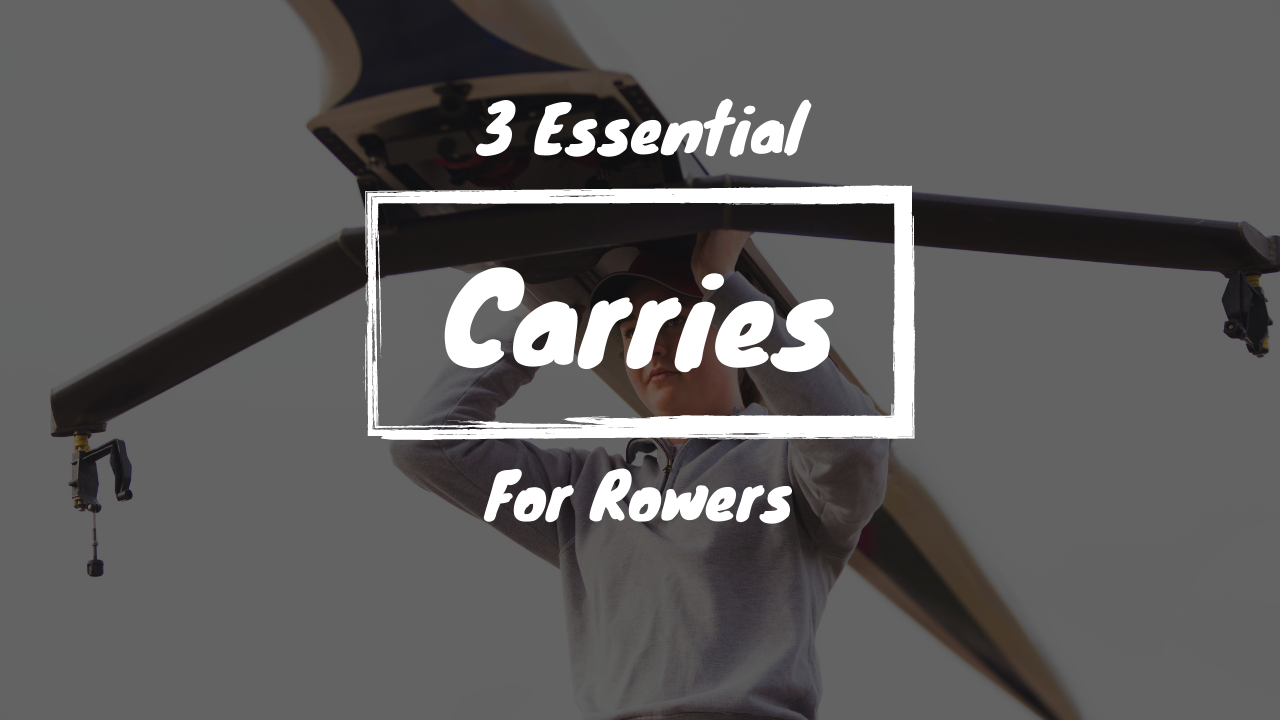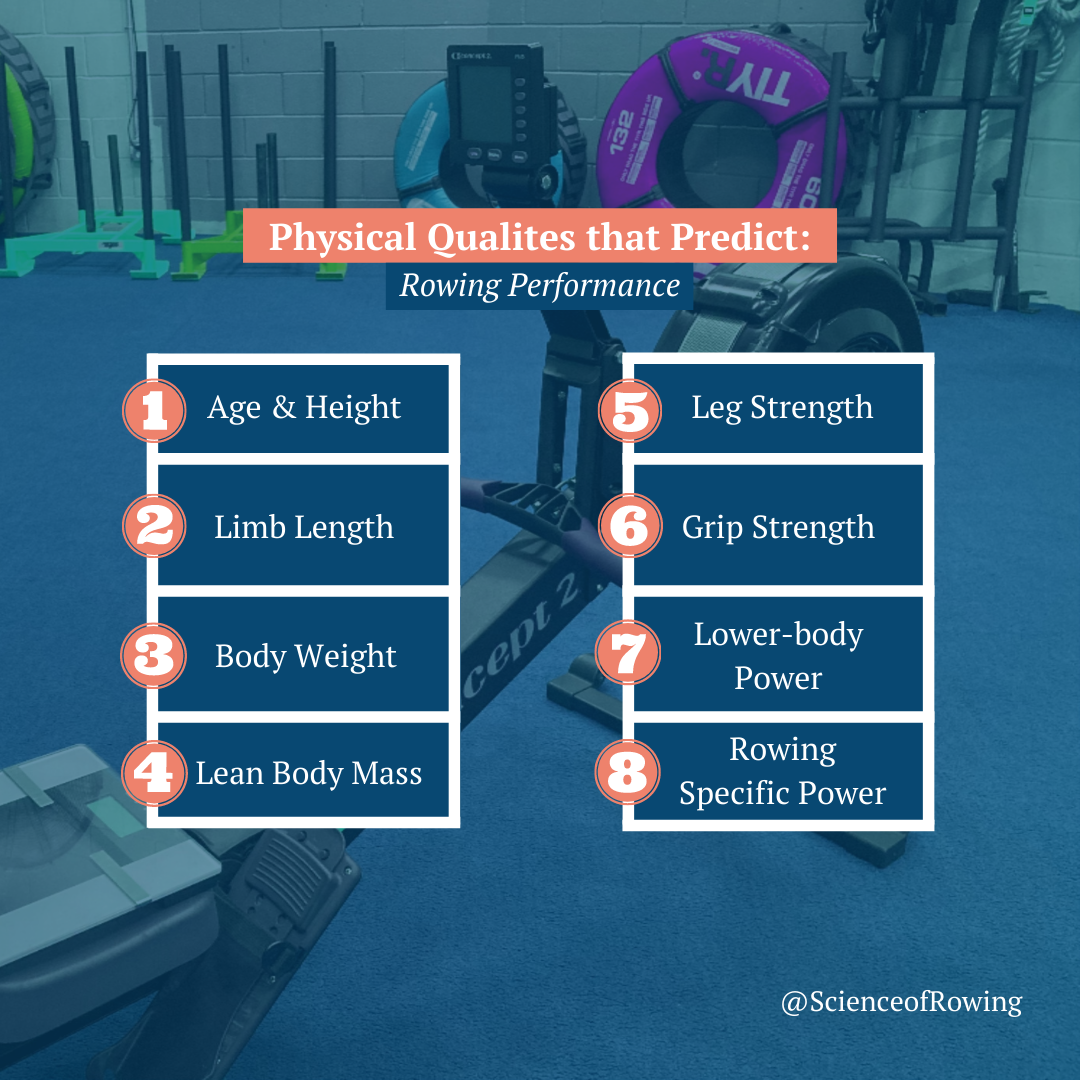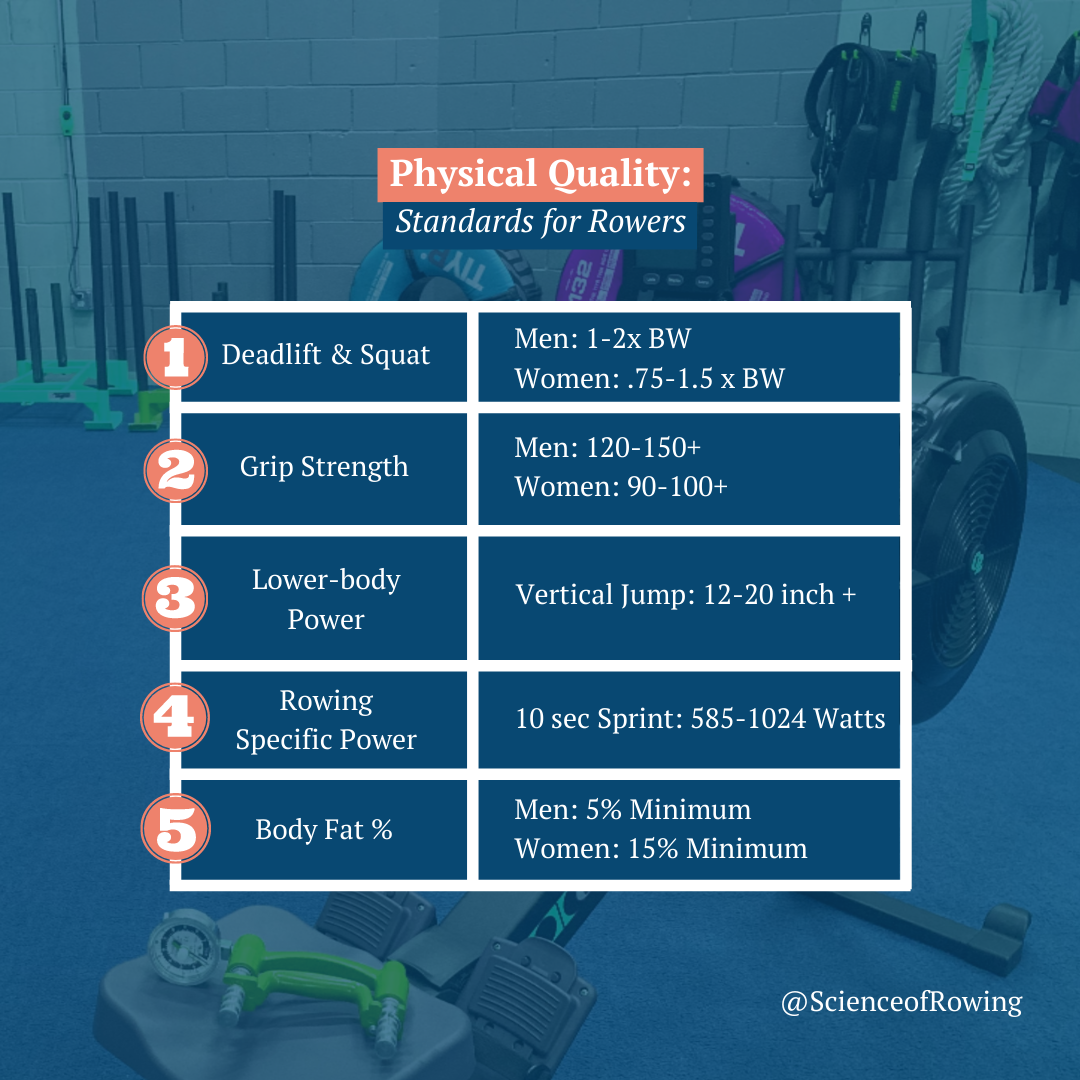"Our hands have a built in protective mechanism. If our bodies aren't prepared to grip something our grip will give out to prevent us from injuring ourselves." Physical Qualities & Rowing Performance Researchers who have studied physical qualities that predict rowing performance have found that age, height, limb length, body weight, lean body mass, leg strength, grip strength, and the ability to produce large amounts of lower-body and rowing specific power, are significantly correlated to 2km rowing performance (1,3,4,5,6,7,9,11). Coaches and rowers can use this information to identify rowing potential, individual limitations, and to target the development of specific qualities that may impact rowing performance. Coaches and rowers can work to develop all of these qualities with the exception of a few genetic variables (height and limb length), alongside other important variables like aerobic fitness and technical abilities. A targeted approach that addresses our biggest limiting factor should give coaches and rowers an advantage over their competition. For this blog post we'll focus on grip strength. To learn more about developing leg strength in rowers refer to my blog posts here: 3 Essential Deadlifts for Rowers 3 Essential Squats for Rowers Deadlifting for Rowers To learn more about developing power in rowers refer to my blog post here: Power Training for Rowers Benefits of Carries for Rowers Incorporating carries into our training can help to increase our grip strength, core strength, and body alignment. This should help rowers transfer power to the stroke more effectively, and make it easier to safely carry our boats. Transferring Power To be fast and efficient, rowers need to be able to transfer the power generated at their footplate, all the way up to their oar handle (2). Rowers often struggle to effectively transfer power at two places: the shoulders and the core. When we don't have proper alignment it's harder for us to express strength and stability at those two places. When we're properly aligned and strong enough to maintain our alignment it's easier for us to transfer power. Grip strength is tightly linked to shoulder stability and overall body alignment. Carries help us to develop those sought after qualities. Use carries to increase your ability to effectively transfer power to your stroke. Lifting & Carrying the Boat We need enough strength to lift and carry our boats to and from the water. A lot of rowers won't initially have enough strength to do so without putting themselves into a dangerous or compromised position. Adding carries to your strength training routine can help to make this easier. Performance, Readiness, & Progress Collecting grip strength data can also help to evaluate performance, readiness, and training progress. Over the course of several years I consistently collected grip strength data from about 120 high school rowers. My goal was to monitor my athlete's progress, readiness, and to see if there was a correlation to rowing performance. If you utilize a solid strength training program that includes carries you will see a significant change in grip strength over the course of a season. Grip strength measures can also be used to measure readiness and seem to adequately predict rowing performance. The top rowers, regardless of the team, consistently had the greatest grip strength. I can, and have, adequately predicted top line ups based on grip strength alone. For example, the top four grip strength measures correctly identified the four rowers who placed first and third at the 2019 US Rowing Youth National Championships in the Varsity Men’s A & B pairs. Grip strength has been tied to numerous benefits such as overall health, longevity, and rowing performance (8,10). This may be due to the fact that our hands are closely connected to our nervous system. Our hands have a built in protective mechanism. If our bodies aren't prepared to grip something our grip will give out to prevent us from injuring ourselves. Hence why grip is typically the first thing to go when lifting weights. Grip strength is at its peak when we're healthy, our bodies are well aligned, and we're well rested. Grip strength is at it's lowest, when our health is challenged, when our body is misaligned, and when we're in need of rest. Since our grip strength is so tightly connected to our nervous system it can be used as a measure to predict readiness, alignment, and stress tolerance. Here is how we can use grip strength measures:
As a coach or rower, when you see significant changes you can use this information to adjust the training program approriately. The really interesting part is that when we checked in with the athletes who had just had a significant drop in grip strength we'd often find one of the following:
Using a consistant measure like grip strength allowed us to adjust training to fit the individual of that day. For measurement I use a grip dynometer from Baseline because of it's lower cost and accuracy. Carry Technique Technique for carries is simple. 1) Pick up a weight safely as if you were deadlifting the weight off the floor 2) Stand long and tall, like you're the tallest and strongest person at the beach 3) Walk with control without losing that position 4) Return the weight to the floor like a heavy deadlift Training Notes Rowing training itself is a grip-intensive activity, and I recommend that rowers and coaches avoid isolated grip strength training exercises. In general, free-weight strength training consisting of barbell, dumbbell, kettlebell, and carry exercises, performed without the aid of grip straps, is sufficient stimulus for most rowers, without overtaxing the forearms. The 3 Essential Carries for Rowers Video Strength Standards In my experience the best rowers has grip strength in these ranges: High School Men: 120-150+ pounds High School Women: 90-100+ pounds These numbers are based on my experience with high school rowers. Your numbers may vary based on your specific demographic. For measurement I use a grip dynometer from Baseline because of it's lower cost and accuracy. Another way to measure this is by having athletes perform a Farmer's carry with at least 50% of their bodyweight in two hand for 60 seconds. If they can do that with good form grip isn't their biggest limitation. My top athletes can do this with 80% of their body-weight. Example: 200 pound athlete 50% BW Farmer's Carry 2x50 dumbbells for 60 seconds 80% BW Farmer's Carry 2x80 dumbbells for 60 seconds Don't get too carried away ;) 1) Bootes, M. (2017) The relationship between rowing ergometer power and jumping characteristics. Journal of Australian Strength and Conditioning 25(6): 50.
2) Baudouin, A, and Hawkins, D. A biomechanical review of factors affecting rowing performance. British Journal of Sports Medicine 36: 396-402, 2002. 3) Bourdin, M, Messonnier, L, Hager, J, and Lacour, J. (2004). Peak power output predicts rowing ergometer performance in elite male rowers. International Journal of Sports Medicine 25(5): 368-373. 4) Chun-Jung, H, Nesser, T, and Edwards, J. (2007) Strength and power determinants of rowing performance. Journal of Exercise Physiology Online 10(4): 43-50. 5) Egan-Shuttler, J, Edmonds, R, Eddy, C, O’neil, V, and Ives, S. (2019). Beyond peak, a simple approach to assess rowing power and the impact of training: A technical report. International Journal of Exercise Science 12(6): 233-244. 6) Gee, T, Olsen, P, Fritzdorf, S, White, Golby, J, and Thompson, K. (2012). Recovery of rowing sprint performance after high intensity strength training. International Journal of Sports Science and Coaching 7(1): 109-120. 7) Ingham, S, Whyte, G, Jones, K, and Nevill, A. (2002). Determinants of 2,000 m rowing ergometer performance in elite rowers. European Journal of Applied Physiology 88(3): 243-246. 8) Majumdar, P., Das, A., Malay, Mandal. (2017). Physical and strength variables as a predictor of 2000m rowing ergometer performance in elite rowers. Journal of Physical Education and Sport, 17(4), 2502-2507. 9) Penichet-Tomás, A, and Pueo, B. (2017). Performance conditional factors in rowing. Factores condicionales de rendimiento en remo. Retos: Nuevas Perspectivas de Educación Física, Deporte y Recreación 32: 238-240. 10) Secher, N. Isometric rowing strength of experienced and inexperienced oarsmen. Medicine and Science in Sports 7: 280-283, 1975. 11) Šmída, M, Clementis, M, Hamar, D, and Macejková, Y. (2017). Relation between maximal anaerobic power output and tests on rowing ergometer. Acta Facultatis Educationis Physicae Universitatis Comenianae 57(1): 68-75.
0 Comments
Leave a Reply. |
Author
Blake Gourley holds a Masters of Science in Sports Performance Training and has over 12+ years of experience working with rowers. Read more Categories
All
Archives
August 2023
|



 RSS Feed
RSS Feed